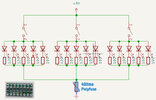Hello,
I would like to ask for a bit of advice on parallel LED strings.
For the past few years, I've made the following circuit for some lights I make as part of my hobby.
I power either from a 5v usb adapter or from a 1.5v battery to 5v dc-dc board.
The strings go into tubes, glass, frosted plastic shapes etc.
I use small transfer board pcbs to hand solder different value 1206 resistors and solder each LED separately using wire wrapping wire or enamel wire.
Theres a picture of the transfer board to the bottom left of the attached picture (it's one from the junk bin - an early attempt at soldering years ago)
I generally have 3 individually switched strings. Each LED has a matched resistor depending upon its forward voltage.
This has worked fine and I have a little jig that allows me to quickly hold the 1206 resistors to the board for hand soldering.
I realise however this could be a lot better, and I think very dependent upon input voltage.
I though it might be better to have a small constant current driver for each string ?
Is there a simple way to do this. I would like to keep the circuit as simple as possible.
Also I would like the possibility of adding a high frequency PWM stage to one of the strings at a later date.
Any help appreciated
I would like to ask for a bit of advice on parallel LED strings.
For the past few years, I've made the following circuit for some lights I make as part of my hobby.
I power either from a 5v usb adapter or from a 1.5v battery to 5v dc-dc board.
The strings go into tubes, glass, frosted plastic shapes etc.
I use small transfer board pcbs to hand solder different value 1206 resistors and solder each LED separately using wire wrapping wire or enamel wire.
Theres a picture of the transfer board to the bottom left of the attached picture (it's one from the junk bin - an early attempt at soldering years ago)
I generally have 3 individually switched strings. Each LED has a matched resistor depending upon its forward voltage.
This has worked fine and I have a little jig that allows me to quickly hold the 1206 resistors to the board for hand soldering.
I realise however this could be a lot better, and I think very dependent upon input voltage.
I though it might be better to have a small constant current driver for each string ?
Is there a simple way to do this. I would like to keep the circuit as simple as possible.
Also I would like the possibility of adding a high frequency PWM stage to one of the strings at a later date.
Any help appreciated


